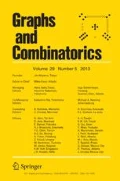Abstract
Difference systems of sets (DSS) are combinatorial structures introduced by Levenshtein in (Probl Peredachi Inform 7(3):215–222, 1971), which are a generalization of cyclic difference sets and arise in connection with code synchronization. In this paper, we consider a collection of pairs in a finite field of a prime order \(p=ef+1\) to be a regular DSS with parameters \((p,2,f,\rho )\). We give a lower bound on the parameter \(\rho \) using cyclotomic numbers for \(e=3\) and 4. In addition, we present a condition for which the collection of pairs forms an optimal DSS for \(e=4\).
Similar content being viewed by others
References
Buratti, M., Pasotti, A.: Combinatorial designs and the theorem of Weil on multiplicative character sums. Finite Fields Appl. 15(3), 332–344 (2009)
Chisaki, S., Miyamoto, N.: Difference systems of sets and a collection of \(3\)-subsets in a finite field of order \(p\). Finite Fields Appl. 34, 75–94 (2015)
Dickson, L.E.: Cyclotomy, higher congruences, and Waring’s Problem. Am. J. Math. 57(2), 391–424 (1935)
Fuji-Hara, R., Momihara, K., Yamada, M.: Perfect difference systems of sets and Jacobi sums. Discret. Math. 309(12), 3954–3961 (2009)
Fuji-Hara, R., Munemasa, A., Tonchev, V.D.: Hyperplane partitions and difference systems of sets. J. Comb. Theory Ser. A 113(8), 1689–1698 (2006)
Fujiwara, Y., Tonchev, V.D.: High-rate self-synchronizing codes. IEEE Trans. Inf. Theory 59(4), 2328–2335 (2013)
Levenshtein, V.I.: One method of constructing quasi linear codes providing synchronization in the presence of errors. Probl. Peredachi Inform. 7(3), 215–222 (1971)
Levenshtein, V.I.: Combinatorial problems motivated by commafree codes. J. Comb. Des. 12, 184–196 (2004)
Mutoh, Y., Tonchev, V.D.: Difference systems of sets and cyclotomy. Discret. Math. 308(14), 2959–2969 (2008)
Storer, T.: Cyclotomy and Difference Sets. Lectures in Advanced Mathematics. Markham publishing company, Chicago (1967)
Tonchev, V.D.: Difference systems of sets and code synchronization. Rend. Sem. Mat. Messina Ser. II 9, 217–226 (2003)
Tonchev, V.D.: Partitions of difference sets and code synchronization. Finite Fields Appl. 11(3), 601–621 (2005)
Tonchev, V.D., Wang, H.: An algorithm for optimal difference systems of sets. J. Comb. Optim. 14(2–3), 165–175 (2007)
Acknowledgments
The authors are grateful to the referee for his/her careful reading of the original version of this paper, his/her helpful comments and valuable suggestions that much improved the quality of this paper.
Author information
Authors and Affiliations
Corresponding author
Appendices
Appendix A
We define the cyclotomic matrix of order e, \((A_{ij})\) : \(0 \le i,j \le e-1\), to be the matrix whose ij-th entry is the integer \((i,j)_e\).
Let \(p=3f +1\) be an odd prime, where \(4p = x^2 + 27 y^2\) with \(x \equiv 1\) (mod 3). Then the cyclotomic numbers of order 3 are given by Table 5 and
Appendix B
Let \(p = 4f+1\) be an odd prime satisfying \(p = x^2 + 4y^2\) and \(x \equiv 1\) (mod 4). When f is odd, the cyclotomic numbers of order 4 are given by Table 6 and
Rights and permissions
About this article
Cite this article
Chisaki, S., Miyamoto, N. Difference Systems of Sets with Size 2. Graphs and Combinatorics 31, 1867–1881 (2015). https://doi.org/10.1007/s00373-015-1593-7
Received:
Revised:
Published:
Issue Date:
DOI: https://doi.org/10.1007/s00373-015-1593-7



